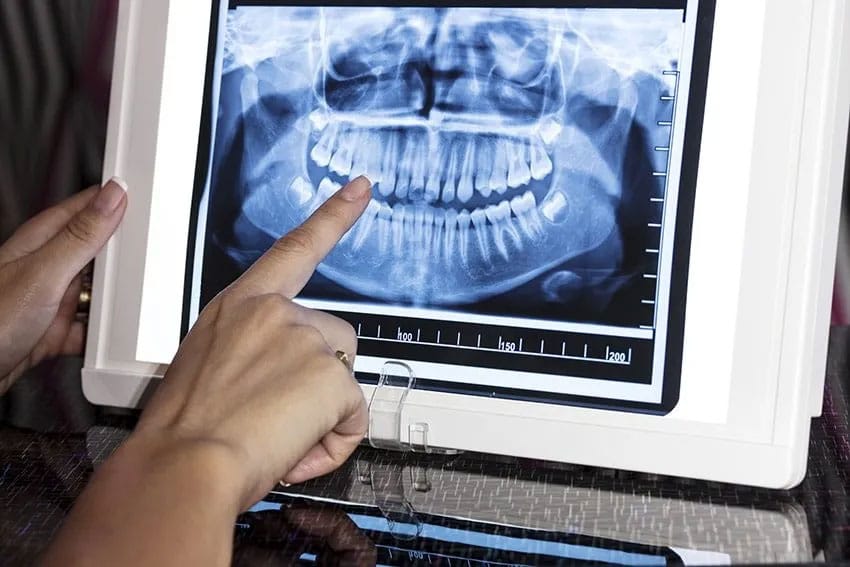X-rays have come a long way down in medical treatment and continues to be indispensable for various processes. It helps to diagnose internal issues that cannot be spotted with the naked eye. Similarly, dental x-rays can detect complications early in your mouth, teeth, gums, and jaw.
Detecting and treating those issues before they get serious can undoubtedly save expenses, suffering, and sometimes, even life. Moreover, the radiation released from a dental x-ray is comparatively small, so this process is pretty safe for people of all ages.
Different types of dental x-rays:
There are varieties of dental x-rays available in modern dentistry to diagnose the relevant problems as early as possible. Although, it has mainly two segments: intraoral x-rays and extraoral x-rays.
- Intraoral X-rays
It is the most common type of x-ray that allows you to get a view of teeth from different aspects. Depending on the site of exposure, there are several types of intraoral x-rays available.
- Bitewing X-rays: It provides a view of the upper and lower teeth in a specific area of the mouth. Bitewing X-rays play a vital role in displaying a tooth from its top portion to the base level. These Bitewing X-rays are applicable in detecting gum disease or any malfunction of dental fillings.
- Periapical X-rays: It helps to get a complete view of the entire tooth, from its crown to the root where the tooth remains attached to the jaw. It allows detection of any trouble or unusual changes in the root or its surrounding bone structures and displays all the teeth of either upper or lower jaw accordingly.
- Occlusal X-rays: Occlusal X-rays display the root or floor of the mouth. Moreover, it helps track extra teeth and teeth that might break due to jaw fractures, cysts, cleft palate, or abscesses. Besides, Occlusal X-rays might appear to be crucial in finding a foreign object in the mouth as well.
- Extraoral X-rays
Extraoral x-rays cannot show the accurate details as intraoral x-rays. Instead, it allows monitoring of problems in the jaw and skull.
- Panoramic X-rays: It shows the complete view of the mouth area, including all the teeth in both the upper and lower jaw with the help of a single ray. It helps in detecting impacted teeth and diagnosing tumors as well.
- Tomograms: Dental tomogram is a two-dimensional image that represents a section of the mouth through a three-dimensional object.
- Sialogram: A sialogram comes handy while diagnosing an obstructed salivary gland or duct in your mouth. Dentists might prescribe this test to detect salivary gland blockage, Sjogren’s syndrome, etc.
- MRI imaging: This imaging method captures a 3D view of the oral cavity, including jaw and teeth.
- Digital imaging: Digital imaging has lots of additional advantages compared to other traditional x-ray methods. As the 2D image is digital, you can enlarge or enhance it according to your requirements. Moreover, the taken images can be sent directly to other dentists for further opinions. Besides, digital imaging uses less radiation than x-rays.
The usage of dental X-rays
Sone efficient usage of dental x-rays is as follows. In adults, it helps to detect:
- Small decayed areas between the teeth
- Decay below existing fillings
- If any bone is missing in the jaw
- Any changes in the bone or root canal caused by infection
- Cysts
- Tumors
- Infection between the gum and a tooth called Abscencess
- The tooth position and condition for tooth implantation or dentures
X-rays provide a more intact view of the overall oral health of children. In children, it helps to detect:
- Any dental disease or decay
- If sufficient room exists in the mouth for the upcoming permanent teeth.
- Existence or absence of adult teeth
- Whether Orthodontic treatment is necessary or not.
- If any unerupted wisdom teeth exist
The reputed dental clinics deploy these treatment processes as and when necessary. In case you need a professional hand to help you with dental issues, make sure to reach out to an established clinic for advanced treatment.


Comments are closed.